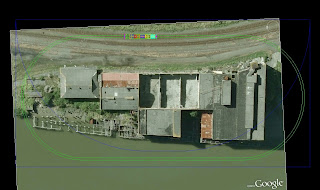DB Resumes:
Over the past few days I got around to putting DJ 3067 back together after its initial DCC test. At the start of this I'd expected to trash a fair bit of the old dog and rebuild it to a better standard, but after trawling around in the rubbish, I found that almost everything I had discarded was actually fairly usable except for the old balsa nose.
So the rear radiators and front dynamics panel were were straightened out and reinstalled, a new nose front and top made from plastic (the new miracle product), and a few details added back on. Including ALL the original handrails (including the nose ones) that had miraculously survived.
A dab of paint here and there and she is pretty much ready to go. I see she needs a bit of gray paint on the back of the hood where I went mad with ATSF blue - strangely enough I only noticed this massive whoopsie in the photo.
While the plan was to build a better DJ, I like that 3067 has retained her character and history as one of my original NZ120 efforts. I've even made the nose details a bit crooked to honour that ;)
...
DJ 3021 is another kettle of fish. Built for the final "Otaki to Cass" exhibition in Christchurch, this one is surprisingly well detailed:
Note the little thin plastic step on the cab front wall so the crew can clean the middle windows, the front wipers made from wire strands, the correct profile to the front edge of the cab roof (notches in above the nearest window wiper), the horns (connected by fine wire), the roof details, the handrails. Hell, the thing is even straight and square in places!
Sure the handrails, grilles, N scale aryan loco assistant and scribed-in panel details are pretty twenty-years-old-coarse when viewed up close, but this isn't a bad model even by today's standards and breaking it apart will be harder on the heartstrings than doing 3067.
The first stroke of luck was being able to pop the back off cleanly and then somehow being able to surgically remove the rear radiator section in one piece (below) to access the screws that fasten the Kato frame halves together. I guess I made this as one piece of thin plastic glued to the frame sides and curved over the top.
From here I carefully removed the nose front and the port side dynamics fan to get to the screw at this end. With some careful levering witha screwdriver between the frame halves, the bogies drop out. A few more careful incisions and we have our two halves.
I did a nice job of making this cab I must say - hopefully it can all be saved during this process!
Above you can see how the outer sides of the widebody Kato shell were milled right down so the motor actually touches an outer skin of super thin plastic.
Note I've also graduated from balsa to stripwood for the structural pieces! This was in the days before todays plethora of plastruct shapes were available in NZ. Interestingly I have a light in 3021, complete with a brass tube directing the light forward. Interesting, because that's the same thing I just installed in 3067!


.jpg)






































